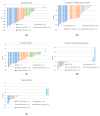The Analysis of Food Intake in Patients with Cirrhosis Waiting for Liver Transplantation: A Neglected Step in the Nutritional Assessment
- PMID: 31618837
- PMCID: PMC6836082
- DOI: 10.3390/nu11102462
The Analysis of Food Intake in Patients with Cirrhosis Waiting for Liver Transplantation: A Neglected Step in the Nutritional Assessment
Abstract
Patients with cirrhosis waiting for liver transplantation (LT) frequently present a nutritional disorder, which represents an independent predictor of morbidity and mortality before and after transplantation. Thus, a proper assessment of the food intake by using different methods, such as food records, food frequency questionnaires, and 24 h recall, should be deemed an important step of the nutritional management of these patients. The available published studies indicate that the daily food intake is inadequate in the majority of waitlisted patients. These findings were confirmed by our experience, showing that the daily intake of total calories, proteins and carbohydrates was inadequate in approximately 85-95% of patients, while that of lipids and simple carbohydrates was inadequate in almost 50% of them. These data highlight the need to implement an effective educational program provided by certified nutritionists or dieticians, who should work in close collaboration with the hepatologist to provide a nutritional intervention tailored to the individual patient requirements.
Keywords: caloric intake; cirrhosis; food records; liver transplantation; macronutrients intakes; malnutrition; patient adherence.
Conflict of interest statement
The authors declare no conflict of interest.
Figures

References
-
- Montano-Loza A.J., Angulo P., Meza-Junco J., Prado C.M., Sawyer M.B., Beaumont C., Esfandiari N., Ma M., Baracos V.E. Sarcopenic obesity and myosteatosis are associated with higher mortality in patients with cirrhosis. J. Cachexia Sarcopenia Muscle. 2016;7:126–135. doi: 10.1002/jcsm.12039. - DOI - PMC - PubMed
-
- Amodio P., Bemeur C., Butterworth R., Cordoba J., Kato A., Montagnese S., Uribe M., Vilstrup H., Morgan M.Y. The nutritional management of hepatic encephalopathy in patients with cirrhosis: International society for hepatic encephalopathy and nitrogen metabolism consensus. Hepatology. 2013;58:325–336. doi: 10.1002/hep.26370. - DOI - PubMed
Publication types
MeSH terms
LinkOut - more resources
Full Text Sources
Other Literature Sources
Medical

